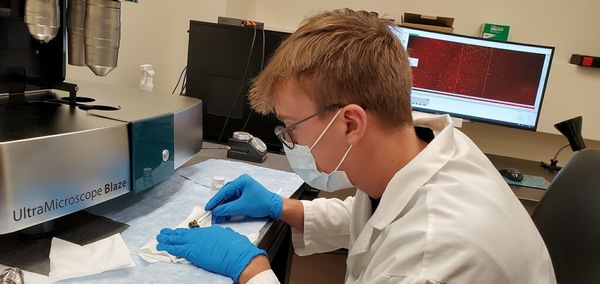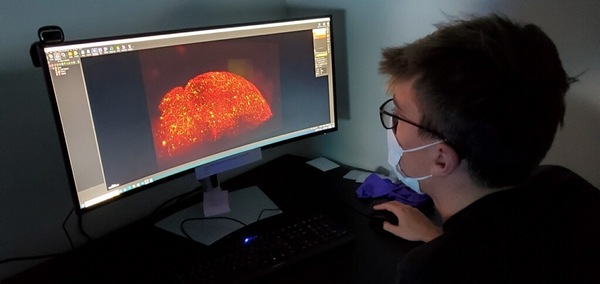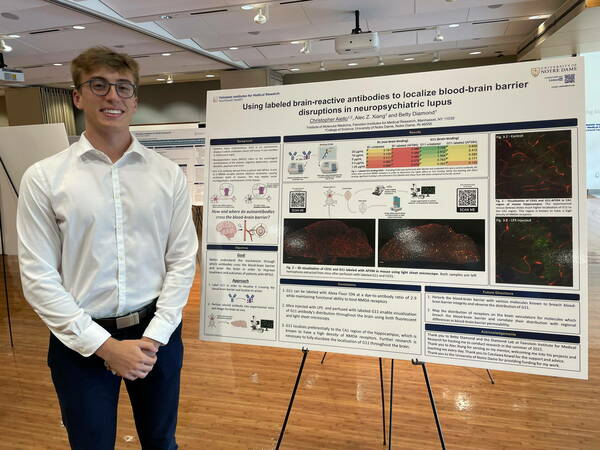
"I walk away from this summer fellowship with so many new skills and abilities that I plan to use in my career as a researcher in the future."
The following reflection was written by undergraduate student Christopher Aiello ('23), a 2022 Precision Medicine Research Fellow recipient at the Feinstein Institute for Medical Research. Learn more about these fellowships here.
"I was incredibly fortunate to have been selected for the Precision Medicine Research Fellowship this summer to conduct research at the Feinstein Institutes for Medical Research. This provided me with my first opportunity to focus exclusively on research for an extended period of time, and confirmed my desire to make medical research a significant part of my career in the future.

I gained placement into my first choice lab for the summer, Dr. Betty Diamond’s immunology lab. I studied the autoimmune disease systemic lupus erythematosus, or SLE. Lupus can affect nearly every organ in the human body. My specific interest was in studying the neuropsychiatric manifestation of the disease. In many lupus patients different neurological symptoms such as seizures, psychosis or cognitive dysfunction has been observed which suggests that the lupus autoantibodies are active in the brain.
In the project I focused on, we used an antibody called G11 which was derived from a human lupus patient. G11 is an autoantibody with cross reactivity to both DNA and the GluN2A subunit of NMDA receptors, where it acts as a positive allosteric modulator. Basically, when G11 allosterically binds to an NMDA receptor on a neuron, it potentiates the effect of glutamate binding causing an influx of ions and ultimately excitotoxic death of the neuron. This may be the mechanism behind some of the neurological symptoms experienced by lupus patients.
The overall goal of my work this summer was to better understand how and where these autoantibodies are able to cross the blood-brain barrier with the long-term goal of improving treatments and outcomes for patients with neuropsychiatric lupus.
To accomplish this goal I first worked to label the G11 antibody with a fluorescent dye without disrupting G11’s binding in order to be able to visualize the antibody in a mouse's brain. Once this was accomplished I then transcardially perfused both control mice and mice injected with LPS to open the blood-brain barrier and then image the brains of both experimental and control mice ex vivo.

Overall, I was able to show that Alexa Fluor 594 can effectively label G11 without abrogating binding, and that mice injected with LPS before being perfused with antibody have much more antibody present in the brain both globally and in specific regions with high NMDA receptor density.
This project marks an important first step in better understanding how brain-specific antibodies may globally affect the brain in neuropsychiatric lupus. Our important next steps include perturbing the blood-brain barrier with specific cytokines (as opposed to the general response the LPS causes) in order to see their individual effects on blood-brain barrier integrity. Additionally, the distribution of receptors on brain vasculature could be mapped and correlated with any regional differences that exist in blood-brain barrier permeability.
Outside of my project, I also assisted with my mentor’s other project that is interested in using extracellular vesicles found in blood serum as a diagnostic measure for lupus. This project is also in its early stages, but it was very interesting to assist with experiments that used human blood samples and was exciting to be doing work that tied so closely with real lupus patients.
I walk away from this summer fellowship with so many new skills and abilities that I plan to use in my career as a researcher in the future. I can now run western blots and ELISAs, handle live mice, perfuse mice and extract their brains, use various microscopes, talk about my research findings in a professional way, and so much more. While the 8 week program did go extremely fast and I cannot believe I am done, when I look back I am so proud of all that I was able to accomplish and how much I grew as a scientist.
I plan to use all that I learned this summer as a stepping stone. I will stay in touch with my mentor, with hopes of even publishing what develops out of the work I did this summer. Outside of Feinstein, I hope to bring my new skills to wherever I end up researching in the future."
-Christopher Aiello
Neuroscience and Spanish Major
Class of 2023

Originally published by at precisionhealth.nd.edu on July 29, 2022.